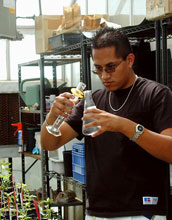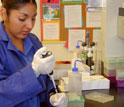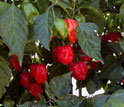News Release 04-082
Pepper Prodigies Pursue Plants Like Those Picked by Parents
Migrant farmworkers' children, grandchildren research at NMSU's Chile Pepper Institute

Baudelio De Santiago, who explored methods of combating a pepper fungus, mixes a batch of ...
June 8, 2004
This material is available primarily for archival purposes. Telephone numbers or other contact information may be out of date; please see current contact information at media contacts.
ARLINGTON, Va.—At the Chile Pepper Institute at New Mexico State University, research can be pretty hot and kind of cool at the same time. There will also be an ancestral sweetness to it for the 10 college freshmen and sophomores in the institute's eight-week summer program, as they are children and grandchildren of migrant and seasonal farmworkers.
The program, in its second summer and running through July 30, is called Assured, for Agriculture Summer Science Research and Development. It provides each student a $3,000 stipend to work in the research labs and design their project, along with room and board at the Las Cruces campus.
The National Science Foundation (NSF), the federal agency responsible for supporting all areas of science and engineering, funds the program.
According to Danise Coon, the program's co-director, Assured introduces students to the process of agricultural research and encourages them toward scientific careers. NMSU agricultural staff and faculty serve as mentors.
"These students come from families who worked the fields, picking crops," she said. "I want them to know the importance of research. I want them to taste the satisfaction they can get from creating knowledge that can enhance a harvest."
Last summer's students seemed to like the taste. From their mentors, they learned about lab techniques, plant breeding, nutrients, and the ethics and process of research. They prepared research posters and presented their findings on topics that included the control of a pepper-blighting fungus, the effect of an herbicide on crops, agricultural economics, and isolation of chile DNA.
For Audrey Viramontes, a student who had worked in onion sheds in her hometown of Hatch, N.M., it was a chance to use high-performance liquid chromatography to determine the pungency of chile peppers.
Another student, Maria Leyva of El Paso, Texas, had worked as a pecan sorter, and her parents had been farm laborers after they immigrated from Mexico. She came into last summer's program saying, "I have always imagined myself as a future scientist." After conducting research on a fungus that can devastate pepper crops, she left Assured with plans to study chemical engineering in agriculture.
The program is funded by a $120,000 grant through NSF's Research Experience for Undergraduates program. NSF funds 114 REU programs in biology across the country. According to Sally O'Connor, a program officer with NSF's Division of Biological Infrastructure, this one is special.
"These students' exposure to plants has been predominantly driven by their economic need to survive," she said. "This program prompts them to ask—and study—some important questions: Can we improve productivity through genetic engineering? How can we make plants resistant to pests? How can we boost the nutritional value of a harvest? For these students, exploring agriculture from this basic research perspective can be exciting and thrilling."
Or, as their contemporaries might say, "sweet" and "hot."
Heat—or pungency—has long been a key focus of pepper research.
Taking measurements in "Scoville heat units" (named for its designer), one chile temperature scale garners its readings by subjecting tasters to a series of increasingly diluted chile extracts, until no heat can be detected.
According to Coon, this summer's Assured students, like their predescessors, will have the opportunity to use the more technical, more precise method of high-performance liquid chromatography to measure a chile's level of capsacinoids, the incendiary compounds responsible for a pepper's ability to burn mouths, noses and eyes.
Others might explore diversity and genetics among peppers, resistance to the fungus responsible worldwide for "chile wilt," and how to boost a pepper's color content.
"Chiles are also grown as a coloring agent," said Coon. "For example, paprika is one of New Mexico's five main chile crops." (The others are cayenne, jalapeno, and the New Mexico green and red peppers.)
Again, at the end of the session, each student will prepare a variation on the "how I spent my summer vacation" report, writing a research paper, making an oral presentation, and designing a scientific poster to illustrate the results.
A supplemental NSF grant will provide two of the students with fellowships to continue their research at NMSU through the next academic year.
-NSF-
-
Marlyn Jacobo uses a pipette to dispense chile DNA into a tubes for genetic analysis.
Credit and Larger Version -
The familiar bell pepper, Capsicum annuum, comes in an array of hues.
Credit and Larger Version -
Among New Mexican peppers, the red savina habanero, a variation of Capsicum chinense, is second ...
Credit and Larger Version
Principal Investigator: Paul Bosland, professor of agriculture, director of Chile Pepper Institute, (505) 646-5171, pbosland@nmsu.edu.
Co-principal investigator: Danise Coon, assistant director, Chile Pepper Institute, (505) 646-3028, hotchile@nmsu.edu.
Chile Pepper Institute at New Mexico State University: http://www.chilepepperinstitute.org/
Assured Program: http://www.chilepepperinstitute.org/Assured.htm
Research Experiences for Undergraduates: http://www.nsf.gov/home/crssprgm/reu/
Abstract of Assured REU award: https://www.fastlane.nsf.gov/servlet/showaward?award=0244179
Media Contacts
Sean Kearns, NSF, (703) 292-7963, email: skearns@nsf.gov
Program Contacts
Sally O'Connor, NSF, (703) 292-8470, email: soconnor@nsf.gov
The U.S. National Science Foundation propels the nation forward by advancing fundamental research in all fields of science and engineering. NSF supports research and people by providing facilities, instruments and funding to support their ingenuity and sustain the U.S. as a global leader in research and innovation. With a fiscal year 2023 budget of $9.5 billion, NSF funds reach all 50 states through grants to nearly 2,000 colleges, universities and institutions. Each year, NSF receives more than 40,000 competitive proposals and makes about 11,000 new awards. Those awards include support for cooperative research with industry, Arctic and Antarctic research and operations, and U.S. participation in international scientific efforts.
Connect with us online
NSF website: nsf.gov
NSF News: nsf.gov/news
For News Media: nsf.gov/news/newsroom
Statistics: nsf.gov/statistics/
Awards database: nsf.gov/awardsearch/
Follow us on social
Twitter: twitter.com/NSF
Facebook: facebook.com/US.NSF
Instagram: instagram.com/nsfgov





